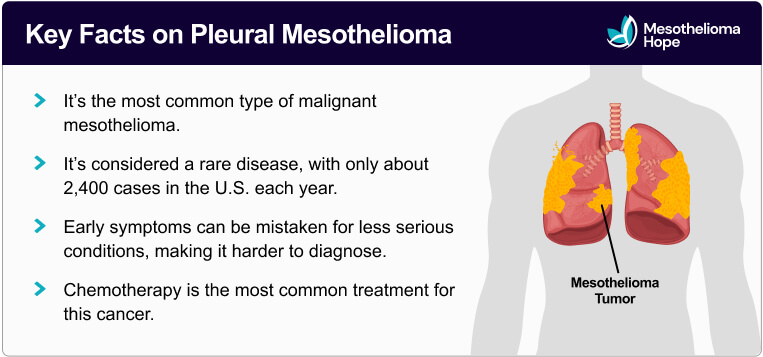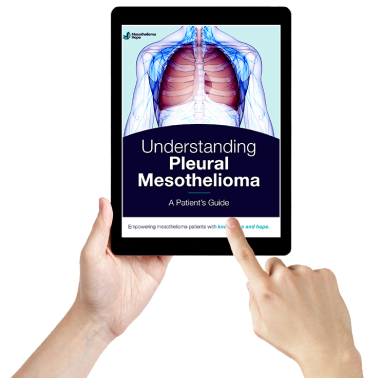What Is Pleural Mesothelioma?
Malignant pleural mesothelioma is a type of cancer that develops in the pleura, the thin lining of tissue surrounding the lungs. The only known cause of pleural mesothelioma is exposure to asbestos, a mineral once widely used in construction, shipbuilding, and other industries.
Pleural mesothelioma is not the same as lung cancer, though they share some symptoms. The only way to get a diagnosis of this type of cancer is to get a biopsy from a doctor. Although there is no cure for pleural mesothelioma, there are several treatment options — and many patients continue to live long, fulfilling lives.

Pleural Mesothelioma Causes
The only known cause of this cancer is asbestos exposure. Asbestos is a naturally occurring mineral once used in many construction and manufacturing products from the 1930s to the early 1980s. Multiple industries, including the U.S. military, used asbestos extensively until it became widely known as a cancer-causing substance (carcinogen).
Some researchers say other factors may play a role. Radiation and genetic mutations, such as BAP1 mutations, can also contribute to the development of mesothelioma — but only in patients who were exposed to asbestos.
How Asbestos Causes Pleural Mesothelioma
- Exposure: Someone inhales or swallows airborne asbestos fibers through direct or secondhand exposure.
- Buildup: Microscopic asbestos fibers become stuck in the lining of the lungs since they are too small to cough up and too tough to dissolve.
- Damage: Over time, asbestos fibers cause inflammation, scarring, and genetic damage to nearby cells.
- Cancer: After 10-50 years, irritation from the fibers causes pleural cells to mutate and grow at an out-of-control rate. The first symptoms of cancer then start to develop.
Malignant Pleural Mesothelioma Risk Factors
Pleural mesothelioma mainly affects older men with working-class and/or military backgrounds. That said, anyone who has been exposed to asbestos may be at risk.
High-risk groups include:
- Anyone exposed to asbestos on the job
- Family members of workers who carried asbestos home on their clothes
- Men over the age of 65
- Veterans, especially those who served in the U.S. Navy
Understanding your risk factors may help you identify your symptoms sooner and guide your conversation with your doctor. If you feel you’re at risk of asbestos exposure and are experiencing symptoms, it’s important to be your own advocate and ask for additional testing.
If you or someone you love was diagnosed with pleural mesothelioma, information is power. Download our Free Pleural Mesothelioma Guide to learn more about this cancer and the most effective ways to treat it.
Pleural Mesothelioma Symptoms
Pleural mesothelioma symptoms can take 10-50 years to appear after asbestos exposure. Most early signs of this cancer are similar to other, less serious conditions, like allergies or the flu. Both of these factors can make it harder to get an accurate diagnosis.
Common warning signs of pleural mesothelioma include:
- Chest pain
- Difficulty breathing and shortness of breath
- Dry, chronic cough
- Fatigue
- Fever
- Night sweats
- Pain or tightness in the chest
- Pleural effusion (excess fluid around the lung)
- Unexplained weight loss
If you’re navigating confusing symptoms or have concerns about asbestos exposure, don’t wait. Talk to your doctor, ask questions, and trust your instincts. Early detection is the best way to treat malignant pleural mesothelioma before it spreads.
Doctors can also help address painful or uncomfortable symptoms through various methods, including pain management, radiation therapy, or draining the excess fluid around your lungs. The right doctor will work with you to create a care plan that treats your symptoms and helps you feel more like yourself.
Diagnosing Mesothelioma of the Pleura
Most people don’t expect to be diagnosed with cancer when they start experiencing early signs of pleural mesothelioma. The symptoms often feel like the flu, pneumonia, or even allergies. That’s why a pleural mesothelioma diagnosis can sometimes take weeks or even months.
Your doctor will usually begin with a physical exam and questions about your medical history. If your symptoms don’t improve or there are signs of something more serious, they may order additional tests to get a clearer picture.
Tests for malignant pleural mesothelioma may include:
- Imaging scans: X-rays, magnetic resonance imaging (MRI) scans, and computerized tomography (CT) scans can help doctors look for signs of cancer in and around the lungs.
- Biopsies: If imaging tests show signs of cancer, biopsies are ordered to extract tissue and/or fluid to test for cancer cells. A biopsy is the only way to confirm a pleural mesothelioma diagnosis.
- Blood tests: Your doctor may draw blood to test for certain biomarkers, or molecules that signal the presence of mesothelioma.
Getting answers can feel scary, but it’s the first and most important step toward finding the right care. An early and accurate diagnosis gives you more treatment options and a better chance of managing the disease. If you’re facing symptoms that don’t feel right, trust your instincts and talk to a doctor.

“One of the most important things I tell patients is to find a doctor who truly specializes in mesothelioma at a facility that treats many cases per year. Experience matters when it comes to mesothelioma.”
Pleural Mesothelioma Misdiagnosis
Doctors sometimes misdiagnose pleural mesothelioma as more common and less severe conditions like pneumonia. This happens more often when patients visit a general physician, who may not have experience diagnosing and treating pleural mesothelioma.
Because of this, it’s helpful to get a second opinion from an experienced mesothelioma specialist. Not only can they confirm a pleural mesothelioma diagnosis, but they can accurately determine other important factors like the cancer cell type and stage to develop the best treatment plan for you.
Get a diagnosis or second opinion from an experienced pleural mesothelioma specialist near you. Our Free Doctor Match program connects you with specialists based on your unique situation and needs.
Pleural Mesothelioma Stages
There are four stages of pleural mesothelioma. Each stage refers to how much cancer is in your body and how far it has spread. The stage of your cancer can impact which treatments your doctor recommends.
Doctors typically use the tumor-node-metastasis (TNM) staging system to classify the stages of pleural mesothelioma. Tumor describes the size and spread of the main tumor; node indicates whether the cancer has spread to nearby lymph nodes; and metastasis shows if the cancer has spread to other parts of the body.
Stage 1
The cancer is in the pleura only and hasn’t begun spreading to other parts of the body. Surgery to remove the cancer may be an option, as well as other life-extending treatments such as chemotherapy or radiation. The median life expectancy at stage 1 is 21 months.
Stage 2
The cancer has spread just past the pleura and may have reached nearby lymph nodes. At this stage, there may be multiple options to extend the patient’s lifetime and manage symptoms, including surgery, chemotherapy, and immunotherapy. The median life expectancy at stage 2 is 19 months.
Stage 3
The cancer has reached nearby tissues, organs, or lymph nodes. Chemotherapy, immunotherapy, or radiation may help limit cancer spread, and symptom-relieving care can help with quality of life. The median life expectancy at stage 3 is 16 months.
Stage 4
The cancer has reached the other side of the chest and the rest of the body. Chemotherapy and immunotherapy may be options, as well as pain management and other symptom-relieving care. The median life expectancy at stage 4 is 12 months.
Malignant Pleural Mesothelioma Life Expectancy
A prognosis is the projected outcome of a disease. Mesothelioma prognosis is typically measured using the following:
- Survival rate, which is the percentage of patients still alive after a set period of time.
- Life expectancy, which is the average length of time people live after a diagnosis, usually measured in months.
Pleural mesothelioma patients have an average life expectancy of 18 months after diagnosis. However, this is just an average. Many patients go on to live far longer and with a better quality of life with the right treatment and support.
Source: Moffitt Cancer Center
Time After Diagnosis Survival Rate
1 year 73%
3 years 23%
5 years 12%
10 years 5%
The average pleural mesothelioma prognosis is not as encouraging as that of other cancers, but you are not a statistic. Mesothelioma survival rates are based on large data sets from people who may not have anything in common with your health or situation. Regardless of your prognosis, there is always hope.
One mesothelioma survivor, Art Putt, received a grim prognosis when he was diagnosed with pleural mesothelioma in 2018. Today, he’s living a full and happy life. Another survivor, John Stahl, was diagnosed with stage 4 pleural mesothelioma in 2019 but is still alive today thanks to chemotherapy treatments.

“Getting a mesothelioma diagnosis can be very scary. So many people go on Google and find either misinformation or information that doesn’t apply to their individual situation. Mesothelioma is not a guaranteed death sentence — there are options that you have.“
Pleural Mesothelioma Treatment
Mesothelioma treatment aims to increase life expectancy, manage symptoms, and improve quality of life. Commonly used treatments for pleural mesothelioma include surgery, chemotherapy, radiation, and immunotherapy. Treatments may also focus on relieving pain and symptoms, which is known as palliative care.
An experienced pleural mesothelioma specialist may recommend a multimodal approach with a combination of several treatments to target different aspects of your cancer. Your specialist will recommend treatments based on your overall health, stage and type of cancer, and other factors.
Chemotherapy
Chemotherapy is the most common treatment for mesothelioma. It circulates cancer-fighting drugs through the body to destroy cancer cells. The most common chemotherapy drugs used to treat pleural mesothelioma are cisplatin and pemetrexed.
Patients can get chemotherapy alone or with other treatments like surgery and immunotherapy. Some patients qualify for heated chemotherapy applied directly to the chest cavity, a procedure known as hyperthermic intrathoracic chemotherapy (HITHOC). HITHOC is performed during pleural mesothelioma surgery.
Immunotherapy
Immunotherapy boosts the body’s immune response to fighting cancer. Mesothelioma cells can sometimes get past the immune system, allowing them to grow and spread rapidly. Immunotherapy works by helping to identify and destroy these mesothelioma cells to slow down the spread of the cancer.
In 2020, the U.S. Food and Drug Administration (FDA) approved Opdivo® (nivolumab) and Yervoy® (ipilimumab) as the first immunotherapy combination to treat pleural mesothelioma. In 2024, the FDA approved pembrolizumab (Keytruda®) for use with chemotherapy as a first-line (initial) treatment of advanced pleural mesothelioma.
In the CheckMate 743 clinical trial, patients with inoperable pleural mesothelioma who received Opdivo and Yervoy lived longer than those who received chemotherapy alone. Many also experienced fewer side effects.
Surgery
Pleural mesothelioma surgery today is only used for some patients who meet specific criteria. Although it used to be a standard treatment for pleural mesothelioma, recent research suggests that surgery may not actually improve patient outcomes over chemotherapy alone. And because it’s so aggressive, many doctors are choosing not to recommend surgery in many cases.
The two most common types of surgeries include:
- Extrapleural pneumonectomy (EPP): An EPP removes the lung closest to the mesothelioma tumors and the lung lining.
- Pleurectomy with decortication (P/D): A P/D leaves the lungs intact but removes the lung lining and tumors. They usually have a lower risk of complications and shorter recovery times when compared to those treated with an EPP.
Radiation
Radiation therapy treats mesothelioma with intense beams of energy targeted directly at tumors to shrink them or slow their growth. It is often used to reduce the symptoms of late-stage pleural mesothelioma. It may also be used alongside chemotherapy or surgery to kill cancer cells and extend life expectancy.
Emerging Treatments
Medical professionals are developing and studying many new mesothelioma treatment options in clinical trials.
Examples of emerging treatments include:
These and other promising treatments offered in clinical trials can bring hope to patients whose cancer has stopped responding to standard therapies.
Palliative Care
Late-stage pleural mesothelioma patients who cannot undergo life-extending treatments can still access therapies called palliative care to reduce pain and discomfort.
Palliative care options include:
- Chemotherapy/immunotherapy: Used to help manage symptoms by slowing cancer growth.
- Partial pleurectomy: This prevents fluid buildup and relieves symptoms by removing part of the pleura.
- PleurX™ catheter: This device helps patients drain pleural effusions at home.
- Talc pleurodesis: Doctors insert medical grade-talc into the pleura using video-assisted thoracoscopic surgery (VATS) to prevent fluid buildup.
- Thoracentesis: This removes extra fluid from the pleura to make breathing easier.
Tell your doctor about all the symptoms you’re facing so they can help determine the right palliative treatments for you. They’re here to help you maintain your quality of life and focus on your family and loved ones as much as possible.
There are multiple treatment options that may be available to you, and it’s important to talk with your care team to determine the best choice. Our Free Checklist of 14 Questions to Ask Your Doctor can help guide your conversation and ensure you are fully informed going into treatment.
Top Pleural Mesothelioma Doctors
Finding a doctor who specializes in pleural mesothelioma can make a major difference in your care. Mesothelioma specialists understand how this cancer behaves, how to tailor treatment to your specific case, and which therapies are most likely to help.
Some top doctors who treat this type of mesothelioma include:
- Dr. Raphael Bueno — Thoracic Surgeon, Brigham and Women’s Hospital in Boston
- Dr. Raja Flores — Thoracic Surgeon, Mount Sinai Hospital in New York
- Dr. Hedy Lee Kindler — Medical Oncologist at the University of Chicago Medicine Comprehensive Cancer Center
- Dr. Corey J. Langer — Medical Oncologist, Penn Medicine’s Abramson Cancer Center in Philadelphia
- Dr. Taylor Ripley — Thoracic Surgeon, Baylor Lung Institute in Houston
- Dr. Anne Tsao — Medical Oncologist, MD Anderson Cancer Center in Houston
Pleural mesothelioma is rare, and most general oncologists don’t treat it often. That’s why it’s important to seek out a dedicated mesothelioma specialist. Look for someone who sees many cases each year, stays current on the latest treatments, and works as part of a multidisciplinary team.
Financial Support for Pleural Mesothelioma Cancer
When you or your loved one is diagnosed with pleural mesothelioma, your priority is to get the right treatment to maximize your length and quality of life. Sadly, as many as 50% of cancer patients and their families struggle to pay for medical bills after a diagnosis. One estimate puts the total cost of pleural mesothelioma treatment at over $400,000 per year.
Thankfully, however, there’s compensation available that can help you pay for everything from immunotherapy drugs to traveling for treatment to buying a wig if you lose your hair during chemo. Our team can help you pursue mesothelioma compensation from the asbestos companies that might have caused you or a loved one to develop this cancer.
We can also help you find travel grants for treatment, understand your health insurance, and apply for VA benefits if you served in the military.
Get Help for Pleural Mesothelioma Today
If you or your loved one has recently been diagnosed with pleural mesothelioma, there’s a lot to consider — and it can be hard to know where to start. Our compassionate, experienced team of Patient Advocates is here to make this journey easier and less overwhelming.
We can help you:
- Understand your diagnosis and pathology report
- Find a specialist for treatment
- Connect with a support group or peer mentor
- Learn about your options for compensation
It’s always free to speak with our team. Call us at (866) 608-8933 or fill out our contact form to get personalized guidance and support now.
Pleural Mesothelioma FAQs
What is the life expectancy of a person with pleural mesothelioma?
Pleural mesothelioma patients have an average life expectancy of 18 months after diagnosis. But life expectancy will vary depending on your individual diagnosis and prognosis. With the right treatment, you may be able to become a long-term survivor.
Treatments like surgery, chemotherapy, immunotherapy, and radiation can help improve your prognosis and allow you to spend more time with the people you love.
What are the symptoms of pleural mesothelioma?
Common signs and symptoms of pleural mesothelioma include difficulty breathing, dry coughing, chest tightness, shortness of breath, and fluid buildup in the lungs.
These symptoms are associated with other respiratory illnesses, so it is important to be seen by a doctor to get a correct diagnosis.
Is pleural mesothelioma curable?
There’s no official cure yet, but some mesothelioma patients have lived 20 years or more after being diagnosed with this cancer. The key is to get medical care from top mesothelioma doctors.
Patients also have a better chance of living longer if they’re diagnosed before the cancer spreads.
Is mesothelioma a painful cancer?
It can be. In early stages, it often starts as a dull, widespread pain in the chest. As the cancer progresses, the pain can worsen.
Pain can be caused by either the tumors themselves or surgeries used to diagnose and treat the disease, according to one study on pain management in pleural mesothelioma patients.
There are many pharmaceutical, surgical, and alternative/holistic methods to address your pain. Talk to your doctor to understand your options and get relief for the pain.
How rare is pleural mesothelioma?
According to the National Institutes of Health (NIH), less than 3,000 people per year are diagnosed with pleural mesothelioma in the United States. For context, there are about 333 million people in the U.S.
Because pleural mesothelioma is so rare, it’s important to find the right doctor and a personal support team that understands every aspect of this cancer and knows what you’re going through.
Call our team at (866) 608-8933 to get the help you need to navigate mesothelioma.
Who is the longest survivor of pleural mesothelioma?
Sissy Hoffman is the longest survivor of pleural mesothelioma. She lived for 29 years after diagnosis, at which point she was given just 6 months to live. Sissy had surgery to remove the entire lung affected by the cancer, becoming the first woman in the United States to undergo this procedure. She passed away in 2025 at the age of 73.











